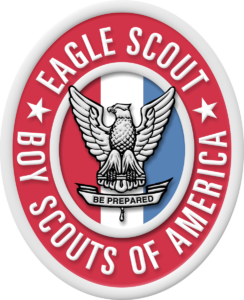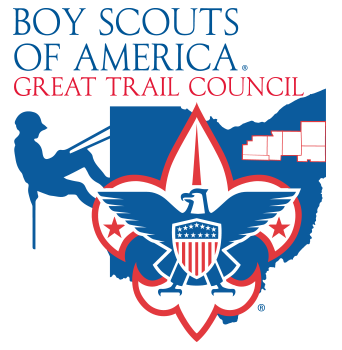Trail to Eagle
Significance of the Eagle Scout Rank
The fact that a boy is an Eagle Scout has always carried with it a special significance, not
only in Scouting but also as he enters higher education, business or industry, and
community service. The award is a performance-based achievement whose standards
have been well-maintained over the years. Not every boy who joins a Boy Scout troop
earns the Eagle Scout rank; only about 5 percent of all Boy Scouts do so. This represents
more than 2 million Boy Scouts who have earned the rank since 1912. Nevertheless, the
goals of Scouting—citizenship training, character development, and personal fitness—
remain important for all Scouts, whether or not they attain the Eagle Scout rank.
Progression
To earn the Eagle Scout rank, the highest advancement rank in Scouting, a Boy Scout
must fulfill requirements in the areas of leadership, service, and outdoor skills. Although
many options are available to demonstrate proficiency in these areas, a number of
specific skills are required to advance through the ranks—Tenderfoot, Second Class, First
Class, Star, Life, and Eagle. To advance, a Boy Scout must pass specific tests that are
organized by requirements and merit badges.
Merit Badges
Merit badges signify the mastery of certain outdoor skills, as well as helping boys increase
their skill in an area of personal interest. Of the 120 merit badges available, 21 must be
earned to qualify for Eagle Scout. Of this group, 12 badges are required, including First
Aid, Citizenship in the Community, Citizenship in the Nation, Citizenship in the World,
Communications, Environmental Science, Personal Fitness, Personal Management,
Camping, and Family Life. In addition, a Scout has a choice between Emergency
Preparedness and Lifesaving and a choice among Cycling, Hiking, and Swimming.
Scoutmaster Conferences
At each of his rank advancements, a Boy Scout takes part in a Scoutmaster conference.
These conferences help the Scout to set goals for himself in line with his individual talents
and abilities. At each conference, the Scoutmaster helps him evaluate how well he
accomplished his present goal and then works with him in setting new goals.
Service and Responsibility
Beginning with the Star rank, and continuing through Life and Eagle, a Scout must
demonstrate participation in increasingly more responsible service projects. At these
levels, he also must demonstrate leadership skills by holding one or more specific youth
positions of responsibility in his patrol and/or troop.
Steps in Advancement
Advancement, one of the eight methods by which the aims of Scouting are achieved, has
four steps through each award level.
First, the Scout learns. Much of his learning comes from other boys in his patrol or troop
and by active participation in troop program. His patrol activities are directed toward the
skills he needs. Every troop hike, camping trip, or other activity offers potential learning
experiences. A Scout learns to pitch a tent by pitching one, to use a compass by finding
directions, and to cook a meal by having to prepare and eat it.
Second, the Scout is tested. The specific requirements determine the kind of testing.
Verbal testing is sufficient in some instances. In other instances, a Scout must
demonstrate his skills by doing.
Third, the Scout is reviewed. The purpose of the review is to ensure that all
requirements for advancement have been met. This includes a check of the Scout’s
attitude and practice of the ideals of Scouting, in addition to his Scoutcraft skills. The
decision regarding whether a Scout has met the required standards to qualify for rank
advancement begins with the troop and, for the Eagle Scout rank, is approved by the
district, local council, and finally, the National Council.
Fourth, the Scout is recognized. The final step in advancement involves presentation of
the badge, usually at a ceremony before the entire troop.
Boy Scouts With Disabilities
Boy Scouts with disabilities may qualify for the Eagle Scout rank. Each Scout must earn as
many of the required merit badges as he can. He then submits an application for alternate
merit badges. His BSA local council determines the alternate merit badges for him to earn.
For more information, please see http://www.nesa.org/trail.html




